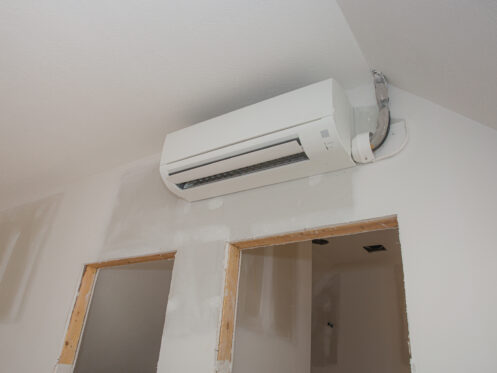A zoned HVAC system is a great investment that will greatly improve your comfort and also help you save on heating and air conditioning costs. This type of system does require lots of work to install since it is usually necessary to redesign and replace at least part of the ductwork. However, a zoned heating system can definitely be worth it and provide great benefits to your home. In this guide, we’ll explain exactly what a zoned HVAC system is, how it works, and everything else you need to know to determine if this type of system is a good choice for your home.
What Is a Zoned Heating System?
A zoned heating system or zoned cooling system splits the home and the duct system up into multiple smaller areas or zones. Each zone is controlled by its own thermostat and an automatic damper in the ductwork that opens as needed to allow air to flow to the zone or closes to block off the zone. A zoned system will allow you to only heat or cool the zones that currently need to be instead of heating and cooling every room at the same time. As a result, this type of system can lower your heating and cooling costs by up to 30% on average.
You could theoretically design the system so that every room in the house is in a separate zone, but this will add a lot to the installation cost and usually isn’t necessary. Still, as long as the system is properly designed, you can easily create individual zones for each bedroom or just for each floor or different part of the house. It really depends on the layout of your house and your specific wants and needs. For instance, if you have a room or part of the house that typically stays too cold or uncomfortably warm in the winter, you’d want to create a separate zone for that area so that it receives more or less heat than the other zones.
What Type of HVAC Units Will Work in a Zoned System?
Generally speaking, you need to have either a two-stage or variable-speed heating or cooling unit for a zoned HVAC system to work effectively. Either a two-stage or variable-speed furnace and air conditioner or heat pump will work in a zoned system, but a zoned system would cause lots of issues for standard single-stage units. A heat pump can usually be the best option since the same unit will heat and cool, which means you’ll save lots of money compared to installing both a furnace and AC. Heat pumps are also the most efficient type of heating and will save you lots of money on your energy bills compared to a furnace.
Single-stage furnaces and heat pumps can only run at full power, which means they produce lots of heat quickly. This isn’t an issue if all or most of the zones are open and calling for heat. However, if only some of the zones are open, all of the heat will get trapped and start building up inside the system so that it quickly starts overheating. This is a bigger issue if the system runs on a furnace, as it can cause the heat exchanger to crack and lead to carbon monoxide leaking out into the home. Whenever the system overheats, the high-temperature limit switch will trigger and shut everything down. You’ll then need to wait for however long it takes for the heat exchanger and/or blower motor to fully cool down before the system will start up again. Some systems must be manually reset after they shut down due to overheating.
Since single-stage units produce so much heat or cooling at a time, they will also often start short cycling if not all of the zones are open. Short cycling is when an HVAC unit runs for less than 10 minutes and then only stays off for a few minutes before starting back up. This is a serious issue as it puts a huge amount of extra strain on the unit, leading to more frequent breakdowns and a much shorter lifespan. Short cycling will also lead to your energy bills being much higher than if the unit only cycled on and off two to three times an hour.
If you were to use a single-stage heat pump or AC to cool a home with a zoned system, you’d also typically have issues with the evaporator coil constantly freezing up any time the system is only cooling some zones. If not all of the zones are open, there will be less warm air coming into the system. When there isn’t sufficient warm air flowing over the coil, the refrigerant won’t absorb much heat and will remain cold enough that condensation on the coil quickly starts freezing.
A two-stage or variable-speed unit generally won’t have any of these same issues since it can adjust the rate of heating and/or cooling. A variable-speed unit will usually be the better option since it has many different settings and can operate at anywhere from around 25 to 100% capacity. Two-stage units only have two settings and will operate at either 100% or between 60 and 70% capacity. This means that a two-stage unit could still occasionally overheat or short cycle if less than 50% of the zones are open.
Understanding How a Zoned HVAC System Is Controlled
In general, you’re usually better off having a few larger zones than lots of small zones. The reason has to do with how a zoned system is controlled. Each thermostat controls the damper to allow air to flow to the zone. If you set the temperature in one zone higher than the others, that zone will generally always receive heat the entire time your heating system runs. Similarly, if the temperature is set lower, the damper will close once the zone reaches the desired temperature. The system, though, will keep running and will continue to supply heat to the other zones.
Each thermostat won’t necessarily be able to control the system and signal it to turn on and off. This is because zoned systems are generally designed so that only some of the thermostats run or control the system. If you split your home up into four zones of similar size, all of the thermostats would typically be able to run the system.
However, zones that are less than 25% of the system’s total capacity typically won’t be control zones. This means that smaller zones may still get colder or warmer than you want until one of the control zones calls for heating or cooling. This normally isn’t an issue for guest rooms or other rooms that are rarely used. However, it could make it more difficult to maintain a consistently comfortable temperature in each bedroom if they were all in separate zones. In this case, the system may not turn on often enough or run long enough to fully heat or cool each bedroom to the desired temperature.
The reason that smaller zones aren’t control zones is that it would often lead to the system turning on and off constantly as the temperature in different zones increased or decreased. It would also lead to a variable-speed unit having the issues we discussed in the previous section since the system would often put out more heating or cooling than what is currently needed. For instance, if the master bedroom was around 15% of the system’s capacity, a variable-speed unit would likely overheat or freeze up if it was only supplying heating or cooling to the master bedroom and not to any of the other zones at the same time.
How We Can help
This is why it is so important that you choose an experienced HVAC contractor to design the zoned system so that it works effectively and meets your specific requirements. You’ll also avoid all of these potential issues. At Marr's Heating and Air Conditioning, our technicians have years of experience designing and installing zoned HVAC systems, and we can ensure you get a system that works right for your home and meets your needs. Give us a call today to learn more about your options for ductless systems, as well as other heating and AC services.

